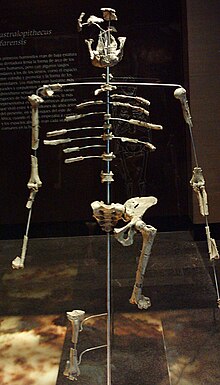Lucy (Australopithecus)
common name for several hundred pieces of bone representing about 40% of the skeleton of an individual Australopithecus afarensis, discovered in Ethiopia in 1974
Lucy is the common name of AL 288-1. This is a fossil discovery of about 40% of the skeleton of a female Australopithecus afarensis. There are several hundred pieces of bone. The discovery was made in 1974, at Hadar in the Awash Valley of Ethiopia's Afar Depression.
 | |
| Catalog no. | AL 288-1 |
|---|---|
| Common name | Lucy |
| Species | Australopithecus afarensis |
| Age | 3.2 million years |
| Place discovered | Afar Depression, Ethiopia |
| Date discovered | November 24, 1974 |
| Discovered by | Johanson and Gray [1] |
This discovery gave us much scientific evidence. Lucy lived about 3.2 million years ago[2] and is a hominid.
The skeleton shows that Lucy had a small skull capacity, like an ape, but also that she walked upright like a human. This supported the view that bipedalism came before the increase in brain size in human evolution. Those features are true of all australopithecines.[3][4]
References
change- ↑ "Instutute of Human Origins". Retrieved 2007-08-30.
- ↑ "Mother of man - 3.2 million years ago". BBC Home. Retrieved 2008-10-10.
- ↑ Johanson D.C. & Maitland A.E. 1981. Lucy: the beginning of humankind. St Albans: Granada, 283–297. ISBN 0-586-08437-1
- ↑ Wood B.A. 1994. Evolution of australopithecines. In Jones S. Martin R. & Pilbeam D. (eds) 2004. The Cambridge encyclopedia of human evolution. 8th ed, Cambridge University Press. ISBN 0-521-46786-1